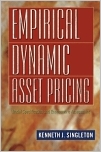| |||||
• polskie
• Zamów informacje o nowościach z wybranego tematu • kontakt |
EMPIRICAL DYNAMIC ASSET PRICINGSINGLETON K.wydawnictwo: PRINCETON, 2006, wydanie Icena netto: Written by one of the leading experts in the field, this book focuses on the interplay between model specification, data collection, and econometric testing of dynamic asset pricing models. The first several chapters provide an in-depth treatment of the econometric methods used in analyzing financial time-series models. The remainder explores the goodness-of-fit of preference-based and no-arbitrage models of equity returns and the term structure of interest rates; equity and fixed-income derivatives prices; and the prices of defaultable securities. Singleton addresses the restrictions on the joint distributions of asset returns and other economic variables implied by dynamic asset pricing models, as well as the interplay between model formulation and the choice of econometric estimation strategy. For each pricing problem, he provides a comprehensive overview of the empirical evidence on goodness-of-fit, with tables and graphs that facilitate critical assessment of the current state of the relevant literatures. As an added feature, Singleton includes throughout the book interesting tidbits of new research. These range from empirical results (not reported elsewhere, or updated from Singleton's previous papers) to new observations about model specification and new econometric methods for testing models. Clear and comprehensive, the book will appeal to researchers at financial institutions as well as advanced students of economics and finance, mathematics, and science. "This book fills a huge gap. It goes beyond the detailed description of
methodology to provide a critical overview of findings in the literature. As a result, it
not only offers the state of the art, but identifies the paths for future research--an
invaluable textbook feature. With more than twenty-five years' worth of incredibly
influential research on the topic, Kenneth Singleton was the perfect person to write
it." Kenneth J. Singleton is Adams Distinguished Professor of Management and Senior Associate Dean for Academic Affairs at the Graduate School of Business, Stanford University. A Fellow of the Econometric Society, he is the recipient of the organization's Frisch Prize. He is also the recipient of the Smith-Breeden Distinguished Paper Award from the Journal of Finance. Singleton is a director of the American Finance Association and was previously an editor of the Review of Financial Studies. He is coauthor, with Darrell Duffie, of Credit Risk: Pricing, Management, and Measurement (Princeton). TABLE OF CONTENTS: Preface Chapter 1: Introduction 1.1. Model Implied Restrictions Part I: Econometric Methods for Analyzing DAPMs Chapter 2: Model Specification and Estimation Strategies 2.1. Full Information about Distributions Chapter 3: Large-Sample Properties of Extremum Estimators 3.1. Basic Probability Model Chapter 4: Goodness-of-Fit and Hypothesis Testing 4.1. GMM Tests of Goodness-of-Fit Chapter 5: Affine Processes 5.1. Affine Processes: Overview Chapter 6: Simulation-Based Estimators of DAPMs 6.1. Introduction Chapter 7: Stochastic Volatility, Jumps, and Asset Returns 7.1. Preliminary Observations about Shape Part II: Pricing Kernels, Preferences, and DAPMs Chapter 8: Pricing Kernels and DAPMs 8.1. Pricing Kernels Chapter 9: Linear Asset Pricing Models 9.1. Economic Motivations for Examining Asset Return Predictability Chapter 10: Consumption-Based DAPMs 10.1. Empirical Challenges Facing DAPMs Chapter 11: Pricing Kernels and Factor Models 11.1. A Single-Beta Representation of Returns Part III: No-Arbitrage DAPMs Chapter 12: Models of the Term Structure of Bond Yields 12.1. Key Ingredients of a DTSM Chapter 13: Empirical Analyses of Dynamic Term Structure Models 13.1. Estimation of DTSMs Chapter 14: Term Structures of Corporate Bond Spreads 14.1. DTSMs of Defaultable Bonds Chapter 15: Equity Option Pricing Models 15.1. No-Arbitrage Option Pricing Models Chapter 16: Pricing Fixed-Income Derivatives 16.1. Pricing with Affine DTSMs References 536 pp., 6 x 9, 32 line illus.26 tables Księgarnia nie działa. Nie odpowiadamy na pytania i nie realizujemy zamówien. Do odwolania !. |


